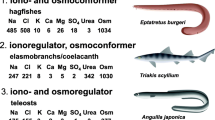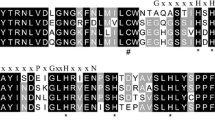Abstract
Epithelial cells in the body wall of adult and developmental stages of marine invertebrates absorb dissolved organic material directly from seawater. Despite over a century of study, little is known about the molecular biological mechanisms responsible for this transport process. Previous studies on embryonic and larval Antarctic echinoderms show that amino acid uptake could provide an important supplement of metabolic substrates. In the present study, partial cDNA sequences of 11 putative amino acid transporter genes were isolated from six species of Antarctic echinoderms including the Antarctic sea stars Acodontaster hodgsoni, Diplasterias brucei, Odontaster meridionalis, Odontaster validus, and Perknaster fuscus, and the Antarctic sea urchin Sterechinus neumayeri. Conserved domains of cDNA-deduced amino acid sequences characterized these genes as being members of a family of amino acid transporters (solute carrier family 6). Expression of these genes was detected throughout embryonic and larval development of two species that have contrasting developmental modes (A. hodgsoni: lecithotrophic; O. meridionalis: planktotrophic). In all six species studied, the expression of amino acid transporter genes was detected in tube feet and digestive organs of adult animals, demonstrating that members of a single amino acid transporter gene family are expressed during the entire life history of a marine invertebrate. The identification of these genes is an important step toward developing a mechanistic understanding of amino acid transport capacities in Antarctic marine invertebrates.



Similar content being viewed by others
References
Allemand D, Derenzis G, Ciapa B, Girard JP, Payan P (1984) Characterization of valine transport in sea urchin eggs. Biochim Biophys Acta 772:337–346
Altschul SF, Gish W, Miller W, Myers EW, Lipman DJ (1990) Basic local alignment search tool. J Mol Biol 215:403–410
Benner R (2002) Chemical composition and reactivity. In: Hansell DA, Carlson CA (eds) Biogeochemistry of marine dissolved organic matter. Academic Press, San Diego, pp 59–90
Beuming T, Shi L, Javitch JA, Weinstein H (2006) A comprehensive structure-based alignment of prokaryotic and eukaryotic neurotransmitter/Na+ symporters (NSS) aids in the use of the LeuT structure to probe NSS structure and function. Mol Pharmacol 70:1630–1642
Bosch I, Pearse JS (1990) Developmental types of shallow-water asteroids of McMurdo Sound, Antarctica. Mar Biol 104:41–46
Boudko DY (2010) Molecular ontology of amino acid transport. In: Gerencser GA (ed) Epithelial transport physiology. Humana Press Inc., New Jersey, pp 379–472
Boudko DY, Kohn AB, Meleshkevitch EA, Dasher MK, Seron TJ, Stevens BR, Harvey WR (2005) Ancestry and progeny of nutrient amino acid transporters. PNAS 102:1360–1365
Bowden DA, Clarke A, Peck LS (2009) Seasonal variation in the diversity and abundance of pelagic larvae of Antarctic marine invertebrates. Mar Biol 156:2033–2047
Bröer S (2008) Amino acid transport across mammalian intestinal and renal epithelia. Physiol Rev 88:249–286
Chen NH, Reith MEA, Quick MW (2004) Synaptic uptake and beyond: the sodium- and chloride-dependent neurotransmitter transporter family SLC6. Pflugers Arch Eur J Physiol 447:519–531
Cheng C–C, Detrich HWI (2007) Molecular ecophysiology of Antarctic notothenioid fishes. Philos Trans R Soc B Biol Sci 362:2215–2232
Clarke A, Leakey RJG (1996) The seasonal cycle of phytoplankton, macronutrients, and the microbial community in a nearshore Antarctic marine ecosystem. Limnol Oceanogr 41:1281–1294
Edwards M, Richardson AJ (2004) Impact of climate change on marine pelagic phenology and trophic mismatch. Nature 430:881–884
Epel D (1972) Activation of an Na+ -dependent amino acid transport system upon fertilization of sea urchin eggs. Exp Cell Res 72:74–89
Ferraris RP, Diamond JM (1989) Specific regulation of intestinal nutrient transporters by their dietary substrates. Annu Rev Physiol 51:125–141
Ginsburg DW, Manahan DT (2009) Developmental physiology of Antarctic asteroids with different life-history modes. Mar Biol 156:2391–2402
Giordano D, Russo R, Di Prisco G, Verde C (2012) Molecular adaptations in Antarctic fish and marine microorganisms. Mar Genomics 6:1–6
Gomme J (2001) Transport of exogenous organic substances by invertebrate integuments: the field revisited. J Exp Zool 289:254–265
Hays G, Richardson A, Robinson C (2005) Climate change and marine plankton. Trends Ecol Evol 20:337–344
He L, Vasiliou K, Nebert DW (2009) Analysis and update of the human solute carrier (SLC) gene superfamily. Hum Genomics 3:195–206
Hoglund PJ, Adzic D, Scicluna SJ, Lindblom J, Fredriksson R (2005) The repertoire of solute carriers of family 6: identification of new human and rodent genes. Biochem Biophys Res Commun 336:175–189
Jaeckle W, Manahan D (1989) Feeding by a “nonfeeding” larva: uptake of dissolved amino acids from seawater by lecithotrophic larvae of the gastropod Haliotis rufescens. Mar Biol 103:87–94
Jaeckle W, Manahan D (1992) Experimental manipulations of the organic composition of seawater—Implications for studies of energy budgets in marine invertebrate larvae. J Exp Mar Biol Ecol 156:273–284
Ji R, Edwards M, Mackas DL, Runge JA, Thomas AC (2010) Marine plankton phenology and life history in a changing climate: current research and future directions. J Plankton Res 32:1355–1368
Johnson CH, Wendt DE (2007) Availability of dissolved organic matter offsets metabolic costs of a protracted larval period for Bugula neritina (Bryozoa). Mar Biol 151:301–311
Jorgensen CB (1976) August Pütter, August Krogh, and modern ideas on the use of dissolved organic matter in aquatic environments. Biol Rev Camb Philos 51:291–328
Kristensen AS, Andersen J, Jorgensen TN, Sorensen L, Eriksen J, Loland CJ, Stromgaard K, Gether U (2011) SLC6 neurotransmitter transporters: structure, function, and regulation. Pharmacol Rev 63:585–640
Manahan DT (1990) Adaptations by invertebrate larvae for nutrient acquisition from seawater. Am Zool 30:147–160
Manahan DT, Wright SH, Stephens GC, Rice MA (1982) Transport of dissolved amino acids by the mussel, Mytilus edulis: demonstration of net uptake from natural seawater. Science 215:1253–1255
Manahan DT, Davis JP, Stephens GC (1983) Bacteria-free sea urchin larvae: selective uptake of neutral amino acids from seawater. Science 220:204–206
Manahan DT, Jaeckle WB, Nourizadeh SD (1989) Ontogenic changes in the rates of amino acid transport from seawater by marine invertebrate larvae (Echinodermata, Echiura, Mollusca). Biol Bull 176:161–168
Marchler-Bauer A, Lu S, Anderson JB, Chitsaz F, Derbyshire MK, DeWeese-Scott C, Fong JH, Geer LY, Geer RC, Gonzales NR, Gwadz M, Hurwitz DI, Jackson JD, Ke Z, Lanczycki CJ, Lu F, Marchler GH, Mullokandov M, Omelchenko MV, Robertson CL, Song JS, Thanki N, Yamashita RA, Zhang D, Zhang N, Zheng C, Bryant SH (2011) CDD: a conserved domain database for the functional annotation of proteins. Nucleic Acids Res 39:D225–D229
Marsh AG, Leong PKK, Manahan DT (1999) Energy metabolism during embryonic development and larval growth of an Antarctic sea urchin. J Exp Biol 202:2041–2050
Meyer E, Manahan DT (2009) Nutrient uptake by marine invertebrates: cloning and functional analysis of amino acid transporter genes in developing sea urchins (Strongylocentrotus purpuratus). Biol Bull 217:6–24
Meyer E, Green AJ, Moore M, Manahan DT (2007) Food availability and physiological state of sea urchin larvae (Strongylocentrotus purpuratus). Mar Biol 152:179–191
Moore M, Manahan DT (2007) Variation among females in egg lipid content and developmental success of echinoderms from McMurdo Sound, Antarctica. Polar Biol 30:1245–1252
Moran AL, Manahan DT (2004) Physiological recovery from prolonged ‘starvation’ in larvae of the Pacific oyster Crassostrea gigas. J Exp Mar Biol Ecol 306:17–36
Pacha J (2000) Development of intestinal transport function in mammals. Physiol Rev 80:1633–1667
Palacin M, Estevez R, Bertran J, Zorzano A (1998) Molecular biology of mammalian plasma membrane amino acid transporters. Physiol Rev 78:969–1054
Pearse JS, McClintock JB, Bosch I (1991) Reproduction of Antarctic benthic marine invertebrates: tempos, modes, and timing. Am Zool 31:65–80
Peck L, Clark M, Clarke A, Cockell C, Convey P, Detrich H, Fraser K, Johnston I, Methe B, Murray A, Romisch K, Rogers A (2005) Genomics: applications to Antarctic ecosystems. Polar Biol 28:351–365
Pütter AFR (1909) Die Ernährung der Wassertiere und der Stoffhaushalt der Gewasser. Fischer, Jena
Rivkin RB (1991) Seasonal patterns of planktonic production in McMurdo Sound, Antarctica. Am Zool 31:5–16
Rivkin RB, Bosch I, Pearse JS, Lessard EJ (1986) Bacterivory: a novel feeding mode for asteroid larvae. Science 233:1311–1314
Saier MH Jr (1999) A functional-phylogenetic system for the classification of transport proteins. J Cell Biochem Suppl 32–33:84–94
Shilling FM, Manahan DT (1994) Energy metabolism and amino acid transport during early development of Antarctic and temperate echinoderms. Biol Bull 187:398–407
Stanwell-Smith D, Peck LS (1998) Temperature and embryonic development in relation to spawning and field occurrence of larvae of three Antarctic echinoderms. Biol Bull 194:44–52
Stephens GC (1988) Epidermal amino acid transport in marine invertebrates. Biochim Biophys Acta 947:113–138
Stephens GC, Schinske RA (1961) Uptake of amino acids by marine invertebrates. Limnol Oceanogr 6:175–181
Stevens BR (2010) Amino acid transport by epithelial membranes. In: Gerencser GA (ed) Epithelial transport physiology. Humana Press Inc., New Jersey, pp 353–378
Welborn JR, Manahan DT (1991) Seasonal changes in the concentration of amino acids and sugars in McMurdo Sound, Antarctica: uptake of amino acids by asteroid larvae. Antarct J US 26:60–162
Wright SH, Manahan DT (1989) Integumental nutrient uptake by aquatic organisms. Annu Rev Physiol 51:585–600
Acknowledgments
This research was undertaken, in part, during the Antarctic Biology Course (National Science Foundation Grant 05-1234124) and by National Science Foundation Grant 01-0980987 to DTM. The authors wish to thank the diving team (Addie Coyac and Jim Leichter) and students (Dafne Eerkes-Medrano, Rob Ellis, Nimrod Kiss, Josh Osterberg, and Sam Rastrick) who assisted with collecting samples from adult echinoderms in McMurdo Sound and Michael Sheng for laboratory assistance. Our thanks to Dr. Ken Hallanych, Alexis Janosik, and Johanna Cannon for sharing information from their RNA analysis of O. validus.
Author information
Authors and Affiliations
Corresponding author
Rights and permissions
About this article
Cite this article
Applebaum, S.L., Ginsburg, D.W., Capron, C.S. et al. Expression of amino acid transporter genes in developmental stages and adult tissues of Antarctic echinoderms. Polar Biol 36, 1257–1267 (2013). https://doi.org/10.1007/s00300-013-1345-1
Received:
Revised:
Accepted:
Published:
Issue Date:
DOI: https://doi.org/10.1007/s00300-013-1345-1




